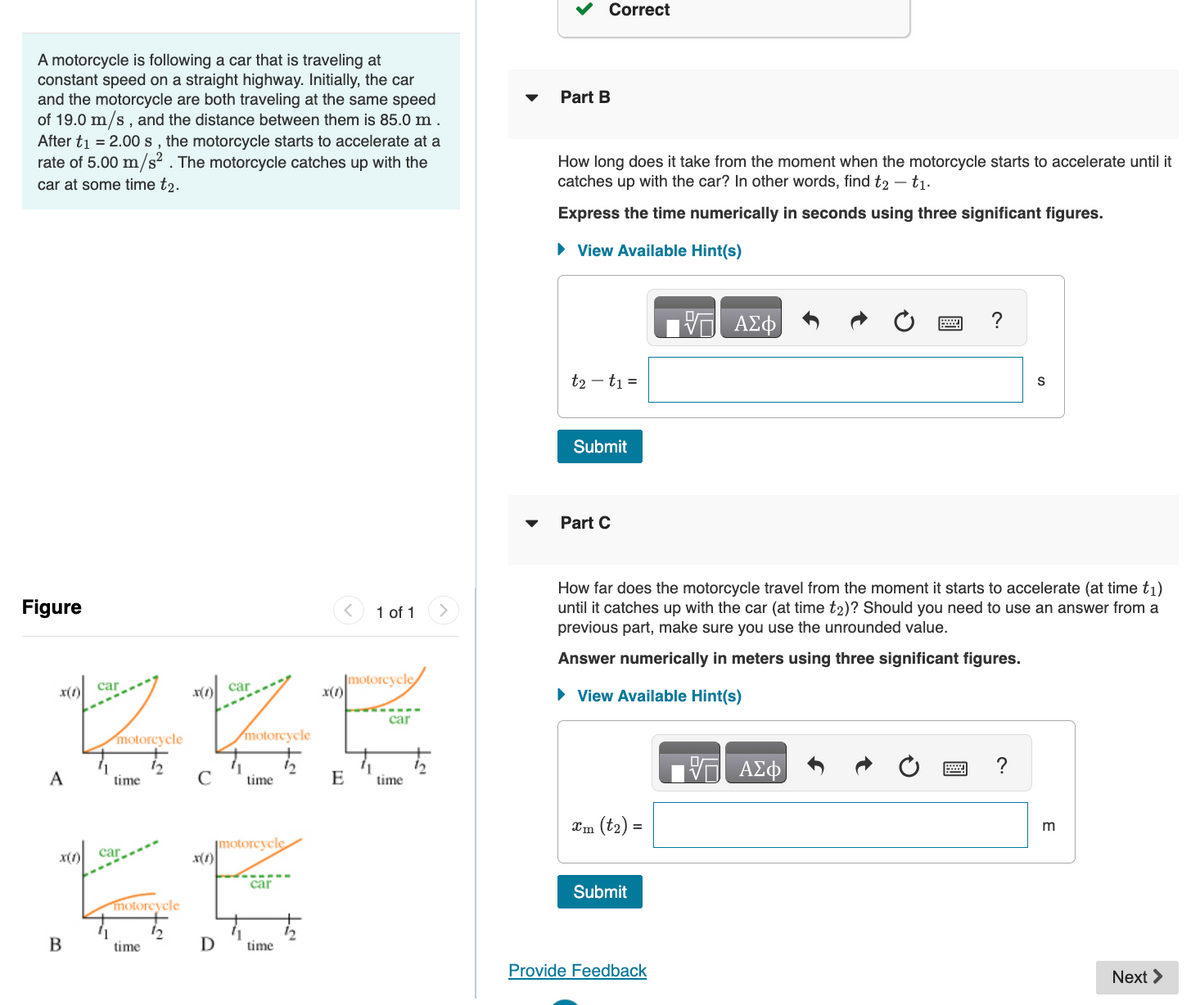A motorcycle is following a car that is traveling at constant speed on a straight highway. Initially, the car and the motorcycle are both traveling at the same speed of 19.0 m/s, and the distance between them is 85.0 m. After t₁ = 2.00 s, the motorcycle starts to accelerate at a rate of 5.00 m/s². The motorcycle catches up with the car at some time t2. Figure x(1) x(1) car BLE motorcycle C time A x(1) B car motorcycle time motorcycle time x(1) motorcycle car D time 1 of 1 x(1) motorcycle car time ▼ ▼ Part B How long does it take from the moment when the motorcycle starts to accelerate until it catches up with the car? In other words, find t2-t₁. Express the time numerically in seconds using three significant figures. ► View Available Hint(s) 17 ΑΣΦ t₂-t₁ = Submit Part C xm (t₂) = How far does the motorcycle travel from the moment it starts to accelerate (at time t₁) until it catches up with the car (at time t2)? Should you need to use an answer from a previous part, make sure you use the unrounded value. Answer numerically in meters using three significant figures. ► View Available Hint(s) Submit ? — ΑΣΦ S ? m
A motorcycle is following a car that is traveling at constant speed on a straight highway. Initially, the car and the motorcycle are both traveling at the same speed of 19.0 m/s, and the distance between them is 85.0 m. After t₁ = 2.00 s, the motorcycle starts to accelerate at a rate of 5.00 m/s². The motorcycle catches up with the car at some time t2. Figure x(1) x(1) car BLE motorcycle C time A x(1) B car motorcycle time motorcycle time x(1) motorcycle car D time 1 of 1 x(1) motorcycle car time ▼ ▼ Part B How long does it take from the moment when the motorcycle starts to accelerate until it catches up with the car? In other words, find t2-t₁. Express the time numerically in seconds using three significant figures. ► View Available Hint(s) 17 ΑΣΦ t₂-t₁ = Submit Part C xm (t₂) = How far does the motorcycle travel from the moment it starts to accelerate (at time t₁) until it catches up with the car (at time t2)? Should you need to use an answer from a previous part, make sure you use the unrounded value. Answer numerically in meters using three significant figures. ► View Available Hint(s) Submit ? — ΑΣΦ S ? m
Principles of Physics: A Calculus-Based Text
5th Edition
ISBN:9781133104261
Author:Raymond A. Serway, John W. Jewett
Publisher:Raymond A. Serway, John W. Jewett
Chapter3: Motion In Two Dimensions
Section: Chapter Questions
Problem 42P: A landscape architect is planning an artificial waterfall in a city park. Water flowing at 1.70 m/s...
Related questions
Question
help pls

Transcribed Image Text:A motorcycle is following a car that is traveling at
constant speed on a straight highway. Initially, the car
and the motorcycle are both traveling at the same speed
of 19.0 m/s, and the distance between them is 85.0 m.
After t₁ = 2.00 s, the motorcycle starts to accelerate at a
rate of 5.00 m/s². The motorcycle catches up with the
car at some time t2.
Figure
x(1)
x(1) car
ZZE
motorcycle
с time
A
car
B
motorcycle
time
x(1) car
x(1)
EE
motorcycle
time
D time
motorcycle
car
1 of 1
x(1)
motorcycle
car
E time
Correct
Part B
How long does it take from the moment when the motorcycle starts to accelerate until it
catches up with the car? In other words, find t2-t₁.
Express the time numerically in seconds using three significant figures.
► View Available Hint(s)
t₂-t₁ =
Submit
Part C
xm (t₂) =
How far does the motorcycle travel from the moment it starts to accelerate (at time t₁)
until it catches up with the car (at time t2)? Should you need to use an answer from a
previous part, make sure you use the unrounded value.
Answer numerically in meters using three significant figures.
► View Available Hint(s)
Submit
Provide Feedback
ΑΣΦ
V
?
ΑΣΦ
?
m
Next >
Expert Solution
This question has been solved!
Explore an expertly crafted, step-by-step solution for a thorough understanding of key concepts.
This is a popular solution!
Trending now
This is a popular solution!
Step by step
Solved in 4 steps

Knowledge Booster
Learn more about
Need a deep-dive on the concept behind this application? Look no further. Learn more about this topic, physics and related others by exploring similar questions and additional content below.Recommended textbooks for you

Principles of Physics: A Calculus-Based Text
Physics
ISBN:
9781133104261
Author:
Raymond A. Serway, John W. Jewett
Publisher:
Cengage Learning

College Physics
Physics
ISBN:
9781938168000
Author:
Paul Peter Urone, Roger Hinrichs
Publisher:
OpenStax College

Glencoe Physics: Principles and Problems, Student…
Physics
ISBN:
9780078807213
Author:
Paul W. Zitzewitz
Publisher:
Glencoe/McGraw-Hill

Principles of Physics: A Calculus-Based Text
Physics
ISBN:
9781133104261
Author:
Raymond A. Serway, John W. Jewett
Publisher:
Cengage Learning

College Physics
Physics
ISBN:
9781938168000
Author:
Paul Peter Urone, Roger Hinrichs
Publisher:
OpenStax College

Glencoe Physics: Principles and Problems, Student…
Physics
ISBN:
9780078807213
Author:
Paul W. Zitzewitz
Publisher:
Glencoe/McGraw-Hill